1998 PONTIAC BONNEVILLE engine
[x] Cancel search: enginePage 88 of 395
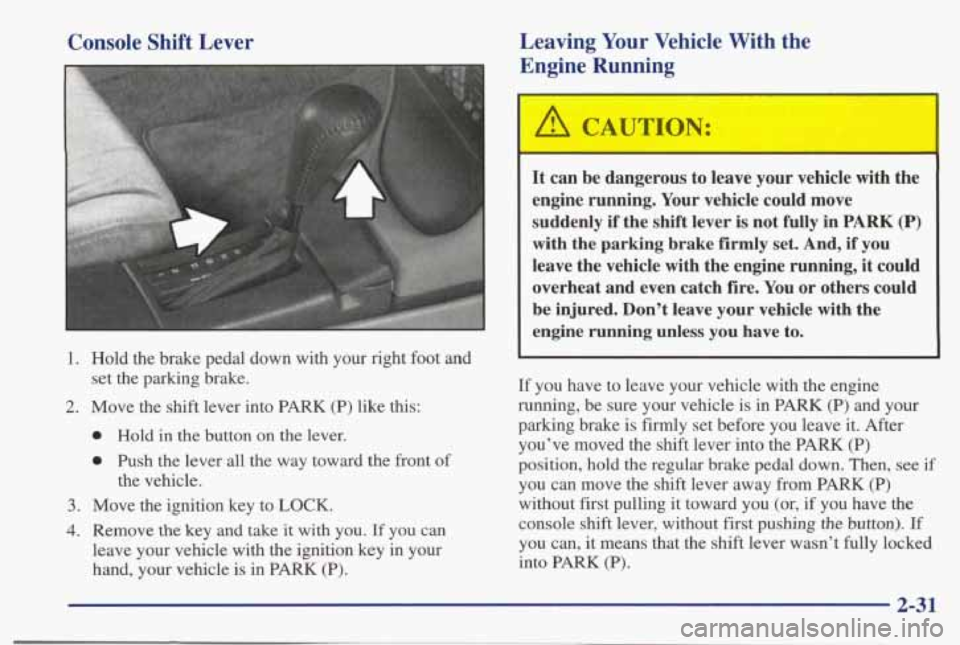
Console Shift Lever Leaving Your Vehicle With
the
Engine Running
1. Hold the brake pedal down with your right foot and
2. Move the shift lever into PARK (P) like this:
set the parking brake.
,I
0 Hold in the button on the lever.
0 Push the lever all the way toward the front of
the vehicle.
3. Move the ignition key to LOCK.
4. Remove the key and take it with you. If you can
leave your vehicle with the ignition key in your
hand, your vehicle is in PARK
(P).
A CAUTION:
It can be dangerous to leave your vehicle with the
engine running. Your vehicle could move
suddenly
if the shift lever is not fully in PARK (P)
with the parking brake firmly set. And, if you
leave the vehicle with the engine running,
it could
overheat and even catch fire. You or others could
be injured. Don’t leave your vehicle with the
engine running unless you have to.
If you have to leave your vehicle with the engine
running, be sure your vehicle is in PARK (P) and your
parking brake is firmly set before you leave it. After you’ve moved the shift lever into the PARK (P)
position, hold the regular brake pedal down. Then,
see if
you can move the shift lever away from PARK (P)
without first pulling it toward you (or,
if you have the
console shift lever, without first pushing
the button). If
you can, it means that the shift lever wasn’t fully locked
into PARK (P).
2-31
Page 90 of 395
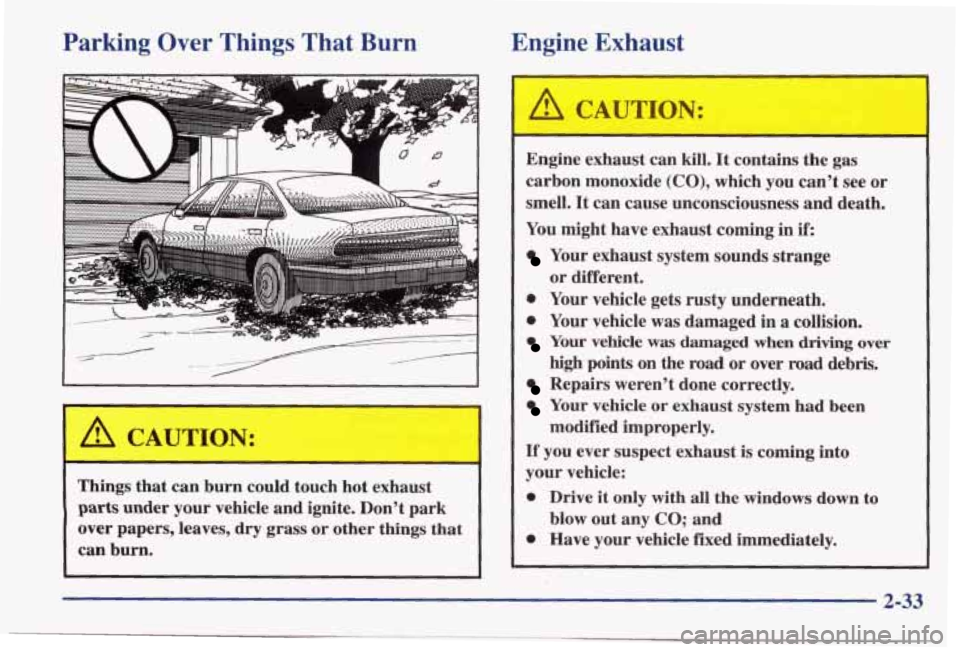
Parking Over Things That Burn
Things that can burn could touch hot exhaust
parts under your vehicle and ignite. Don’t park
over papers, leaves,
dry grass or other things that
can burn.
Engine Exhaust
Engine exhaust can kill. It contains the gas
carbon monoxide (CO), which you can’t see or
smell. It can cause unconsciousness and death.
You might have exhaust coming in
if:
Your exhaust system sounds strange
0 Your vehicle gets rusty underneath.
0 Your vehicle was damaged in a collision.
Your vehicle was damaged when driving over
high pints on the road or over road debris.
Repairs weren’t done correctly.
Your vehicle or exhaust system had been
If you ever suspect exhaust is coming into
your vehicle:
0 Drive it only with all the windows down to
0 Have your vehicle fixed immediately. or
different.
modified improperly.
blow out any
CO; and
2-33
Page 91 of 395
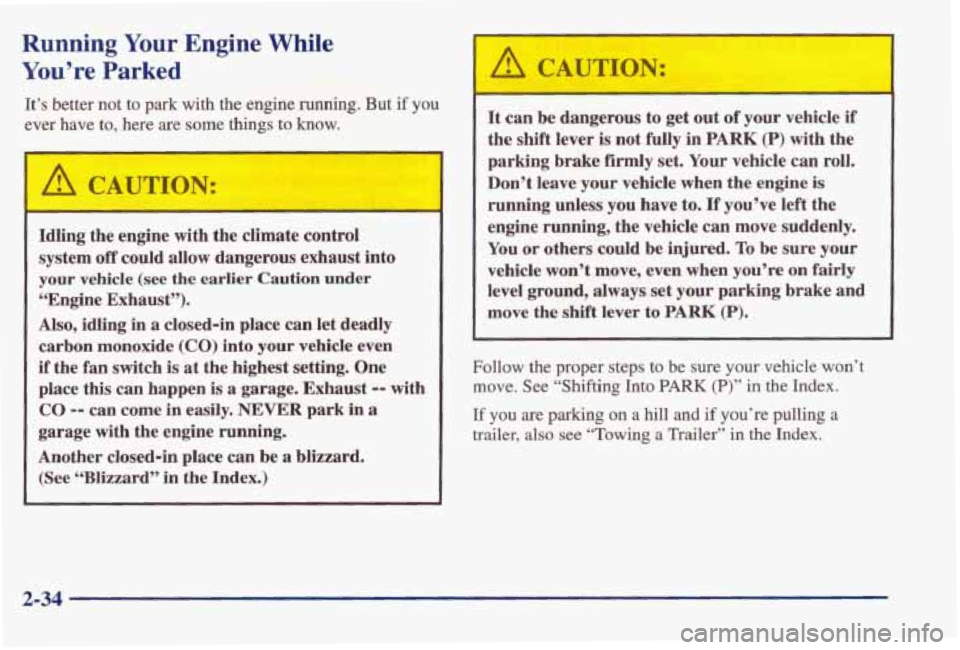
Running Your Engine While
You’re Parked
It’s better not to park with the engine running. But if you
ever have to, here are some things to know.
&A CAUTION:
Idling the engine with the climate control
system
off could allow dangerous exhaust into
your vehicle
(see the earlier Caution under
“Engine Exhaust”).
Also, idling in a closed-in place can let deadly
carbon monoxide
(CO) into your vehicle even
if the fan switch is at the highest setting. One
place this can happen is a garage. Exhaust
-- with
CO -- can come in easily. NEVER park in a
garage with the engine running.
Another closed-in place can be
a blizzard.
(See
“Blizzard” in the Index.)
-
1
I
It can be dangerous to get out of your vehicle if
the shift lever is not
fully in PARK (P) with the
parking brake
firmly set. Your vehicle can roll.
Don’t leave your vehicle when the engine
is
running unless you have to. If you’ve left the
engine running, the vehicle can move suddenly.
You or others could be injured.
To be sure your
vehicle won’t move, even when you’re
on fairly
level ground, always set your parking brake and
move the shift lever
to PARK (P).
Follow the proper steps to be sure your vehicle won’t
move. See “Shifting Into
PARK (P)” in the Index.
If you are parking on a hill and if you’re pulling a
trailer, also see “Towing a Trailer” in the Index.
2-34
Page 104 of 395
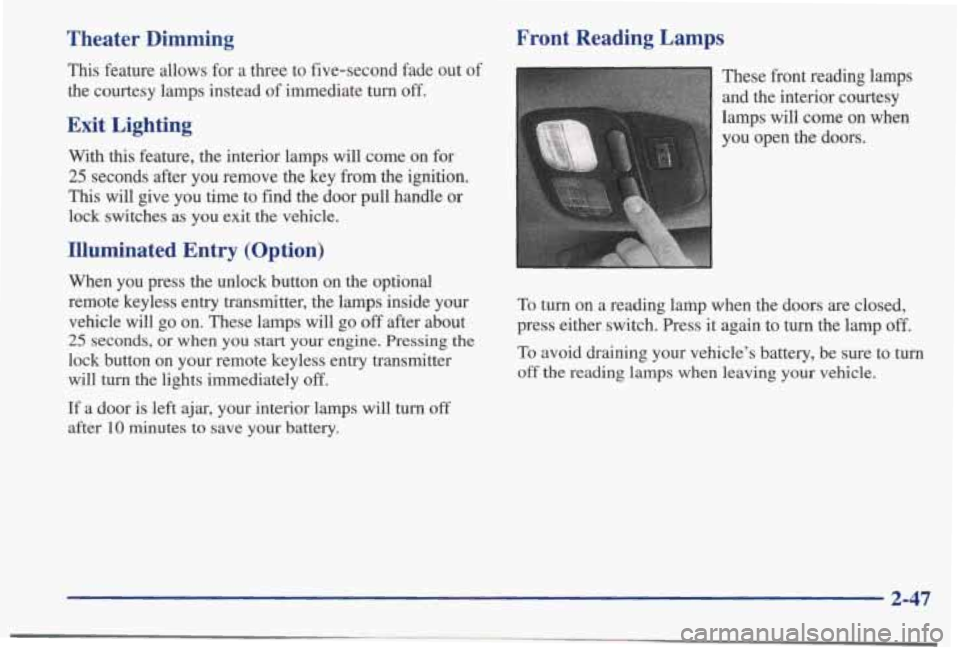
Theater Dimming
This feature allows for a three to five-second fade out of
the courtesy lamps instead of immediate turn off.
Exit Lighting
With this feature, the interior lamps will come on for
25 seconds after you remove the key from the ignition.
This will give you time to find the door pull handle or
lock switches as you exit the vehicle.
Illuminated Entry (Option)
When you press the unlock button on the optional
remote keyless entry transmitter, the lamps inside your
vehicle will
go on. These lamps will go off after about
25 seconds, or when you start your engine. Pressing the
lock button on your remote keyless entry transmitter
will turn the lights immediately
off.
If a door is left ajar, your interior lamps will turn off
after 10 minutes to save your battery.
Front Reading Lamps
These front reading lamps
and the interior courtesy
lamps will come on when
you open the doors.
To turn on a reading lamp when the doors are closed,
press either switch. Press it again to turn the lamp
off.
To avoid draining your vehicle’s battery, be sure to turn
off the reading lamps when leaving your vehicle.
2-47
Page 119 of 395
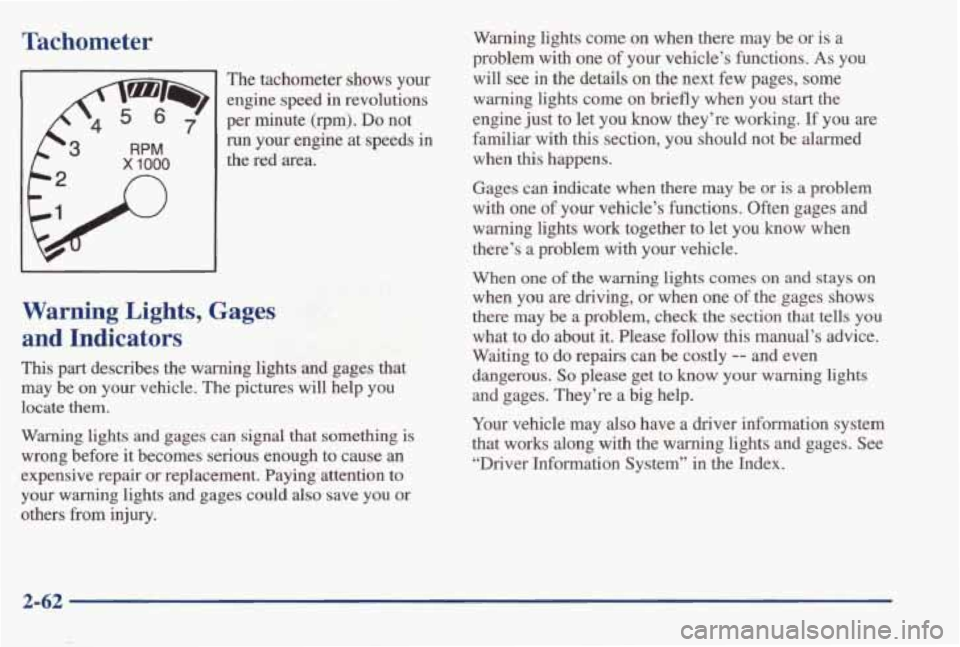
Tachometer
x 1000
n
’ The tachometer shows your
engine speed
in revolutions
per minute
(rpm). Do not
run your engine at speeds in
the red area.
Warning lights come on when there may be or is a
problem
with one of your vehicle’s functions. As you
will see in the details on the next few pages, some
warning lights come on briefly when
you start the
engine just to let you know they’re working.
If you are
familiar with
this section, you should not be alarmed
when
this happens.
Gages can indicate when there may
be or is a problem
with one of your vehicle’s functions. Often gages and warning lights work together to let you know when
there’s a problem with your vehicle.
Warning Lights, Gages
and Indicators
This part describes the warning lights and gages that
may be on your vehicle. The pictures will help you
locate them.
Warning lights and gages can signal that something is
wrong before it becomes serious enough to cause an
expensive repair or replacement. Paying attention
to
your warning lights and gages could also save you or
others from injury.
When one of the warning lights comes on and stays on
when you are driving, or when one of the gages shows
there may
be a problem, check the section that tells you
what to
do about it. Please follow this manual’s advice.
Waiting to
do repairs can be costly -- and even
dangerous.
So please get to know your warning lights
and gages. They’re a big help.
Your vehicle may
also have a driver information system
that works along with the warning lights and gages. See “Driver Information System’’
in the Index.
2-62
Page 120 of 395
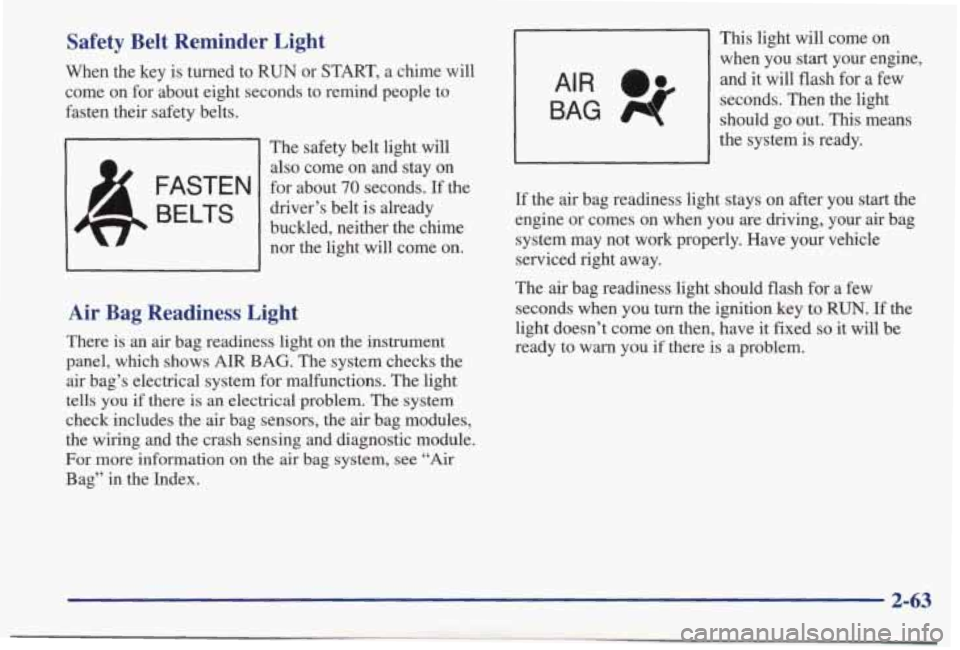
Safety Belt Reminder Light
When the key is turned to RUN or START, a chime will
come on for about eight seconds to remind people to
fasten their safety belts.
The safety belt light
will
also come on and stay on
for about
70 seconds. If the
driver’s belt is already
buckled, neither the chime nor the light will come
on.
Air Bag Readiness Light
There is an air bag readiness light on the instrument
panel, which shows
AIR BAG. The system checks the
air bag’s electrical system for malfunctions. The light
tells you if there
is an electrical problem. The system
check includes
the air bag sensors, the air bag modules,
the wiring and the crash sensing and diagnostic module.
For more information on
the air bag system, see “Air
Bag” in the Index.
BAG 4
AIR a*
This light will come on
when you start your engine,
and it will flash
for a few
seconds. Then the light
should go
out. This means
the system is ready.
If the air bag readiness light stays on after you start the
engine or comes on when you are driving, your
air bag
system may not work properly. Have your vehicle
serviced right away.
The
air bag readiness light should flash for a few
seconds when you
turn the ignition key to RUN. If the
light doesn’t come on then, have it fixed
so it will be
ready to
warn you if there is a problem.
2-63
Page 121 of 395
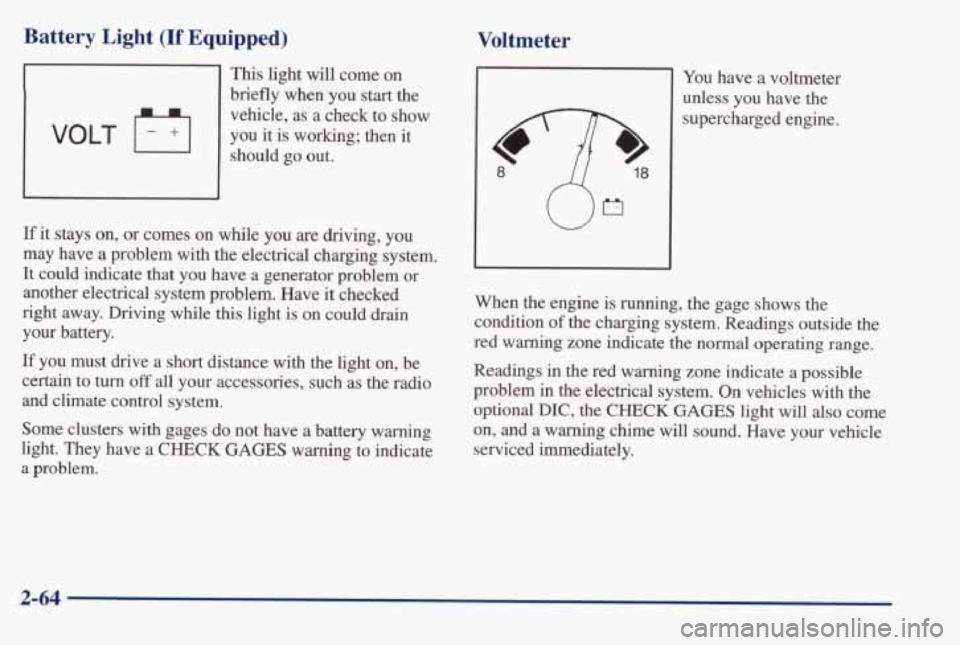
Battery Light (If Equipped)
This light will come on
briefly when you start the
vehicle, as a check to
show
should go out. VOLT F+I you it is working; then it
If it stays on, or comes on while you are driving, you
may have a problem with the electrical charging system.
It could indicate that you have a generator problem or
another electrical system problem. Have it checked
right away. Driving while
this light is on could drain
your battery.
If you must drive a short distance with the light on, be
certain to turn off all your accessories, such as the radio
and climate control system.
Some clusters with gages do not have a battery warning
light. They have
a CHECK GAGES warning to indicate
a problem.
Voltmeter
I You have a voltmeter
unless you have the
supercharged engine.
When the engine is running, the gage shows the
condition
of the charging system. Readings outside the
red
warning zone indicate the normal operating range.
Readings
in the red warning zone indicate a possible
problem in the electrical system.
On vehicles with the
optional DIC,
the CHECK GAGES light will also come
on, and
a warning chime will sound. Have your vehicle
serviced immediately.
2-64
Page 123 of 395
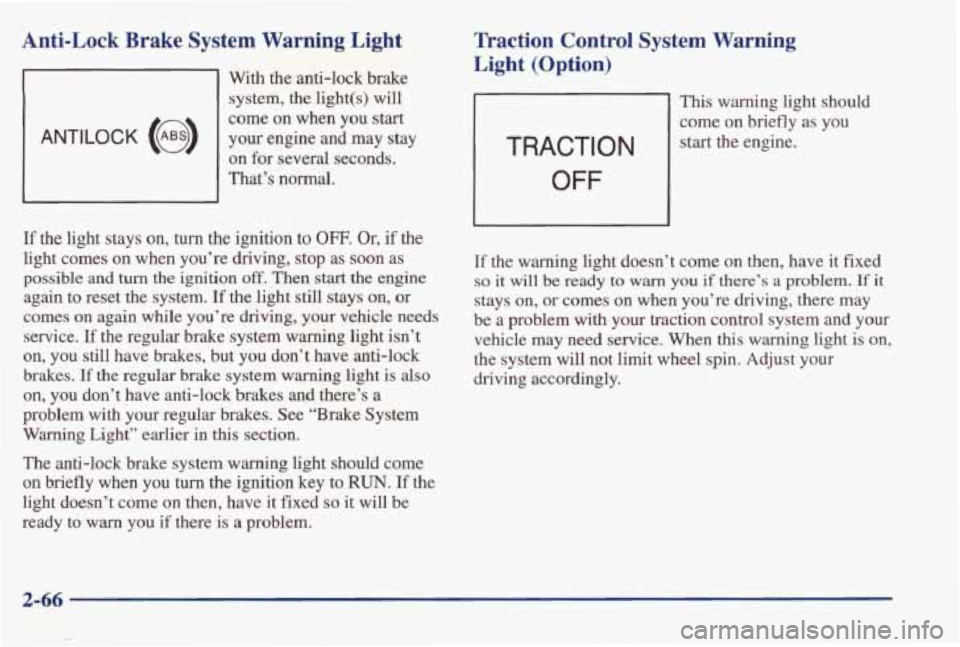
Anti-Lock Brake System Warning Light
ANTILOCK (@)
With the anti-lock brake system,
the light(s) will
come on when
you start
your engine and may stay
on for several seconds.
That’s normal.
llraction Control System Warning
Light (Option)
TRACTION
OFF
This warning light should
come on briefly as you
start the engine.
If the light stays on, turn the ignition to OFF. Or, if the
light comes on when you’re driving, stop as soon as
possible
and turn the ignition off. Then start the engine
again to reset the system.
If the light still stays on, or
comes on again while you’re driving, your vehicle needs
service. If the regular brake system warning light isn’t
on, you still have brakes, but you don’t have anti-lock
brakes.
If the regular brake system warning light is also
on, you don’t have anti-lock brakes and there’s a
problem with your regular brakes. See “Brake System
Warning Light” earlier in
this section.
If the warning light doesn’t come on then, have it fixed
so it will be ready to warn you if there’s a problem. If it
stays on, or comes on when you’re driving, there may
be a problem with your traction control system and your
vehicle may need service. When this warning light is on,
the system will not limit wheel spin. Adjust your
driving accordingly.
The anti-lock brake system warning light should come
on briefly when you turn the ignition key to RUN. If the
light doesn’t come on then, have it fixed
so it will be
ready to
warn you if there is a problem.